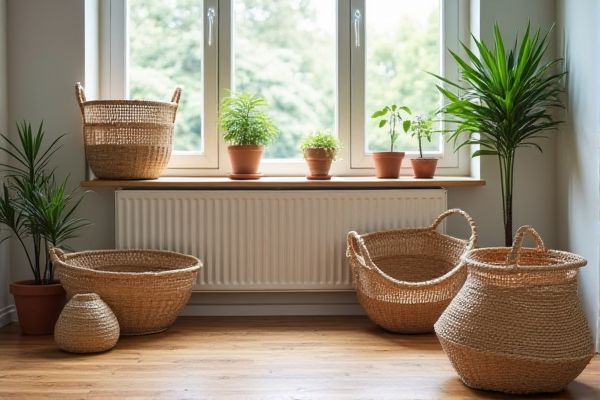
Woven baskets offer a natural, breathable storage solution that enhances your home's aesthetic while reducing plastic waste, unlike plastic bins which provide durability and easy cleaning but can contribute to environmental pollution. Discover the key differences in functionality, sustainability, and style to choose the best option for your storage needs by reading the rest of the article.
Table of Comparison
| Feature | Woven Baskets | Plastic Bins |
|---|---|---|
| Material | Natural fibers (rattan, wicker, seagrass) | Durable plastic (polyethylene, polypropylene) |
| Durability | Moderate; susceptible to moisture and wear | High; resistant to water, impact, and chemicals |
| Weight | Lightweight | Varies; typically heavier than woven baskets |
| Environmental Impact | Biodegradable and eco-friendly | Non-biodegradable; recyclable |
| Design & Aesthetics | Natural, rustic, and decorative | Functional, available in various colors and sizes |
| Maintenance | Requires occasional cleaning, avoid moisture | Easy to clean and maintain |
| Cost | Typically higher due to craftsmanship | Generally lower and mass-produced |
| Use Cases | Home decor, light storage, gift packaging | Heavy storage, organization, outdoor use |
Introduction to Storage Solutions
Woven baskets provide a natural, breathable, and eco-friendly storage option, ideal for organizing household items while adding a rustic aesthetic. Plastic bins offer durable, stackable, and moisture-resistant storage, suited for heavy-duty use and space optimization in garages or basements. Choosing between woven baskets and plastic bins depends on the balance of style, functionality, and intended storage environment.
Material Composition: Woven Baskets vs Plastic Bins
Woven baskets are typically crafted from natural materials such as rattan, seagrass, or bamboo, offering eco-friendly and biodegradable properties. Plastic bins consist of synthetic polymers like polypropylene or polyethylene, providing durability, water resistance, and ease of cleaning. The material composition of woven baskets promotes sustainability, while plastic bins emphasize longevity and moisture protection.
Environmental Impact and Sustainability
Woven baskets, typically made from natural fibers like wicker, bamboo, or rattan, offer biodegradable and renewable alternatives to plastic bins, reducing long-term landfill waste and microplastic pollution. Plastic bins, derived from fossil fuels, contribute significantly to carbon emissions during production and persist in the environment for hundreds of years, negatively impacting ecosystems. Choosing woven baskets supports sustainable resource use and lowers environmental footprint, aligning with zero-waste and eco-friendly lifestyle initiatives.
Durability and Longevity Comparison
Woven baskets, typically made from natural fibers like rattan or seagrass, offer moderate durability but tend to degrade with prolonged exposure to moisture and heavy weight. Plastic bins provide superior longevity due to their resistance to water, impact, and chemicals, making them ideal for heavy-duty storage and long-term use. When comparing durability, plastic bins outperform woven baskets in terms of strength and resistance to environmental wear.
Aesthetic Appeal and Home Décor
Woven baskets provide a natural, rustic aesthetic that enhances home decor by adding texture and warmth to any room, often complementing bohemian, farmhouse, and minimalist styles. Plastic bins, while functional and available in various colors, generally lack the organic charm and visual softness that woven materials offer. Choosing woven baskets over plastic bins can elevate the overall ambiance, making storage solutions a part of the interior design rather than just practical items.
Versatility and Storage Capacity
Woven baskets offer natural breathability and aesthetic appeal, making them ideal for storing delicate items like linens, toys, and clothes while enhancing room decor. Plastic bins provide superior durability, stackability, and waterproof qualities, enabling efficient organization of heavier or moisture-sensitive goods in garages, basements, or closets. Choosing between woven baskets and plastic bins depends on balancing versatility in usage with the required storage capacity and protection level.
Maintenance and Cleaning Requirements
Woven baskets require gentle cleaning with a soft brush or cloth to remove dust and debris, avoiding prolonged exposure to water to prevent mold growth and material weakening. Plastic bins offer hassle-free maintenance with the ability to be washed thoroughly using water and soap, resisting stains and moisture damage effectively. Choosing between these options depends on balancing the natural aesthetic and delicate upkeep of woven baskets against the durability and easy cleaning of plastic bins.
Cost Considerations and Value for Money
Woven baskets typically offer a higher initial cost compared to plastic bins but provide greater durability and aesthetic appeal, enhancing long-term value for money. Plastic bins are more affordable upfront and lightweight, making them cost-effective for temporary or large-scale storage needs. Evaluating cost considerations depends on usage frequency, desired longevity, and visual preference, with woven baskets proving cost-efficient over time despite their premium price.
Health and Safety Aspects
Woven baskets, made from natural materials like rattan or bamboo, offer better breathability and reduce moisture buildup, minimizing mold growth and promoting a healthier storage environment. Plastic bins can emit volatile organic compounds (VOCs) and may harbor bacteria if not cleaned properly, posing potential health risks. Choosing woven baskets supports safer air quality and reduces chemical exposure, enhancing overall health and safety.
Conclusion: Choosing the Right Storage Option
Woven baskets offer a natural, eco-friendly storage solution with breathability that helps prevent moisture buildup, making them ideal for organic materials or decorative use. Plastic bins provide durable, lightweight, and moisture-resistant storage, suitable for long-term organization and protection from pests. Selecting the right storage option depends on factors such as environmental impact, storage conditions, and aesthetic preferences.
 homyna.com
homyna.com